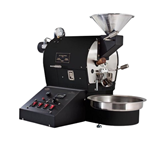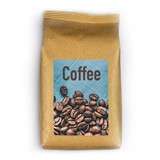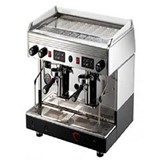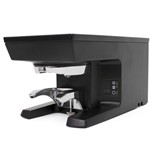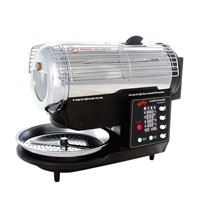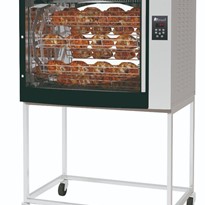Well, we’re here to help. Our aim is to guide you so you can find the best commercial coffee roaster for your needs. Experts agree that roasting your own coffee is a positive and profitable move. With our detailed and informative buyer’s guide, you’ll be well on your way to picking a suitable one.
In Australia, coffee is serious business, and that’s putting it mildly. Our coffee culture is refined and consumers are knowledgeable. For a coffee shop that prides itself in dishing out flavourful coffee, investing in a good professional coffee roaster is a smart step.
From bean to cup, every step of the journey is a critical one. It’s a journey that keeps bringing a customers back to their favourite haunts. Roasting beans is an exact science. Weight of the batch, duration of roast and a host of other parameters are expertly monitored. While the whole process may sound daunting, the outcome can be highly rewarding.
“The globl coffee roaster market size was valued at USD 1.22 billion in 2021 and is expected to expand at a Compound Annual Growth Rate (CAGR) of 6.3% from 2022 to 2030.” - Grand View Research
Adding a commercial roaster to your coffee brewing arsenal gives you better control over your coffee’s taste profile. Commercial roasters let you create the kind of roast profile most preferred by your customers. The nuanced art of creating sumptuous coffee becomes a lot more achievable by investing in a reliable commercial coffee roaster.
If you’re venturing into the café business or looking to upgrade your current set-up, getting a commercial coffee roaster is the way to go. Moreover, having a coffee roaster as part of your café adds an aesthetic charm to the place. It also adds authenticity to your establishment. It shows a serious commitment in delivering the best.
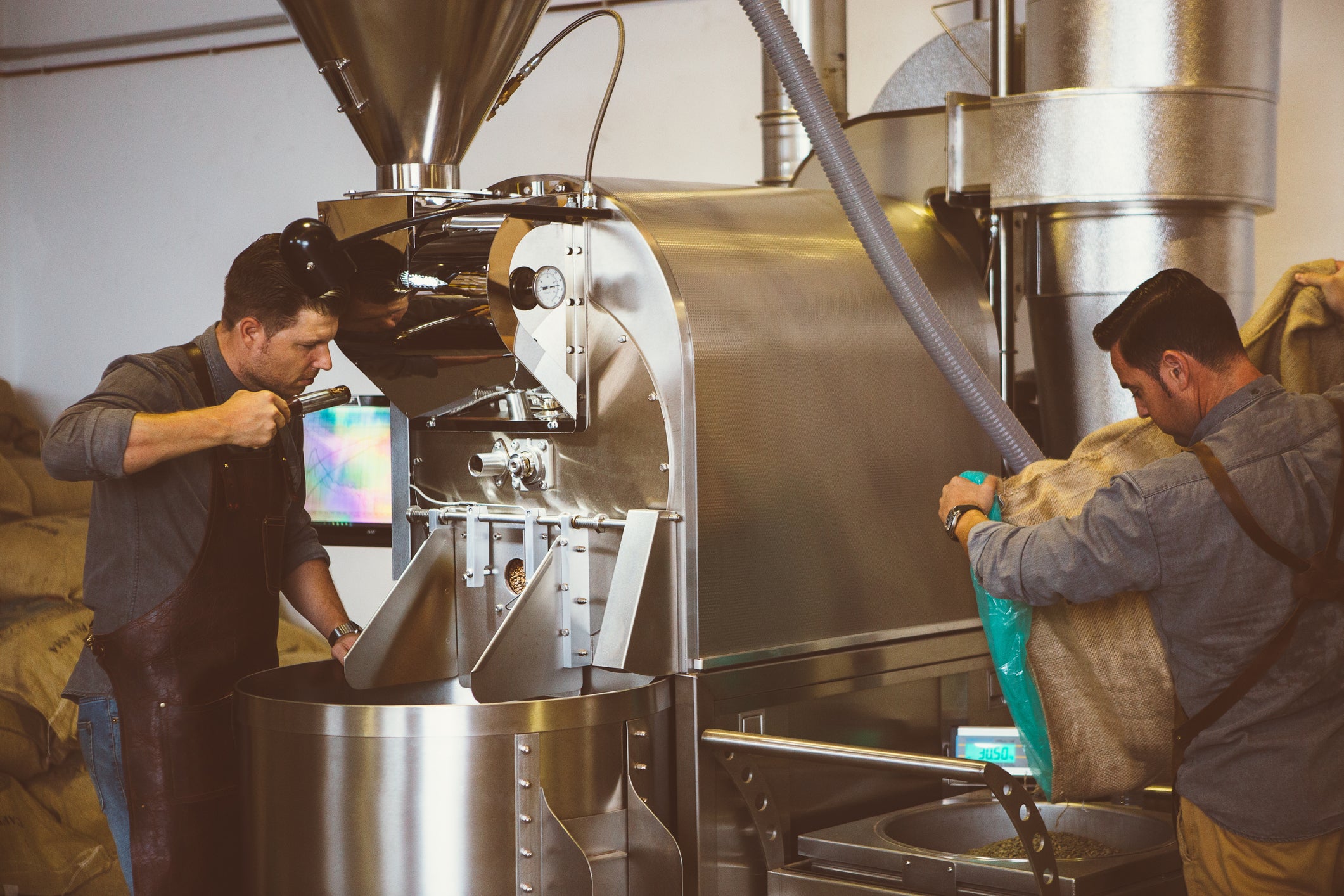
In this buyer’s guide, we’ll cover the important aspects of buying a commercial coffee roaster, including the different types, makes and models. Also, the next time you search for “commercial coffee roasters for sale” online, make sure you consider the used ones too. They’re generally reliable and a good option to consider. This buyer’s guide will also help you navigate the ‘used industrial coffee roaster’ options available.
Buying an industrial roaster or a commercial coffee roasting machine is a crucial purchase. We're here to equip you to make an informed choice on the best fit for your business.
Here’s what our commercial coffee roaster guide covers:
- Commercial coffee roaster terminology
- Main things to consider before ordering a commercial coffee roaster
- Types of coffee roasters – the best one for you
- Used coffee roasters – a worthwhile option?
- Costs to consider when buying or upgrading to a new commercial coffee roaster
- Best commercial brands of coffee roasters
- Top questions to ask before you order a commercial coffee roaster
- Commercial coffee roaster FAQs
Commercial coffee roaster terminology:
Roast profiling: As a roaster, one needs to record the temperatures and duration of various roast stages and monitor many other variables during the roasting process. This is done to document various patterns, tests and results. This entire process is called roast profiling.
Charge: The preheating of all the roasting equipment. This is done before the green coffee beans are fed into the machine.
Drying cycle stage: This is the first step of the coffee roasting process after preheating. In this phase, the beans reach a temperature of about 99 degrees Celsius. They change colour, from green to a light yellow.

Development stage: Chemical processes begin as the temperature rises and the coffee beans start to roast. All these processes ideally happen in the development stage. Technically starting at the first crack, the development stage is the crucial phase during which the profile of the coffee bean is created. It consists of many complex reactions. A few of these are closely monitored to achieve the desired results.
First crack: The water inside the beans vaporises at around 205 degrees Celsius. It causes them to expand and crack, physically and audibly. Before cracking, the beans change colour from green to a light brown. After this first crack, the bean doubles in size. At this stage, the bean has lost about 5% of its water weight.
Pyrolysis: Carbon dioxide is released inside the bean due to chemical changes that occur when the temperature touches the 220 degrees Celsius mark. The colour of the beans changes to a medium brown. During pyrolysis, beans lose up to 13% of their weight.
Second crack: As pyrolysis continues and the temperatures reach 225–230 degrees Celsius, the bean approaches a stage known as the second crack. It’s when the cellulose of the bean’s cell wall breaks apart. The colour of the bean is now medium to dark brown and has an oily sheen to it. Aromatic compounds are released during this step, which contribute to the coffee's flavour.
Cooling stage: This is the final roasting stage, during which the beans are transferred to a cooling tray and are hit with cool air. The tray is also spun to accelerate the cooling. The temperature of the beans drops from about 200 degrees celsius to room temperature in a matter of minutes.
Chaff: Unroasted coffee beans usually have a significant amount of a paper-like substance attached to them. This undesirable substance is removed during the roasting process. As the roasting beans grow in size, this skin either ruptures, tears or is burnt away. Whatever bits of this dried-out, silver skin remains is known as chaff. Most commercial coffee bean roasters separate the chaff using cyclone separators. These clean chaff and dust from the roaster exhaust and deposit it into a metal bin for disposal.
Degassing: Freshly roasted beans release carbon dioxide rapidly. It’s a natural process. Most industrial coffee roasters will leave the freshly roasted coffee for up to 24 hours so that it can de-gas. Once it’s degassed, quality assessment can be carried out.
Infrared heater: There are many ways to heat the drum that roasts the coffee beans. This heater uses infrared waves instead of electric coils or a flame.
Direct flame heater: This heater uses gas in combination with a direct flame to heat the drum that roasts the coffee beans.
Drum roaster: This is a type of roaster in which the beans are shaken and stirred by a large spinning unit/container. This helps in distributing the beans for an even roast. This type of roaster is considered to be the standard when it comes to commercial coffee roasting.
Fluid bed roaster/ Air roaster: In this roaster, hot air is forced through and around the beans. These roaster are used in homes and for small-scale commercial roasting.
"In Australia, coffee is serious business and that's putting it mildly"
Bean probe: This probe is placed amidst the beans to measure the temperature of the beans being roasted. It provides constant readings throughout the roasting process.
Moisture analyser: This device helps roasters gauge the moisture levels of beans that have yet to be roasted. This helps them ensure the beans aren’t spoiled during the roasting process or under-roasted.
RoR (rate of rising): The number of degrees per minute by which the temperature of the beans increases at any point during a roast. This data is constantly monitored throughout the roast and plotted on a graph to achieve what is known as a roast curve. A roast master will monitor the RoR to achieve a predetermined roast curve to deliver a batch of roasted beans with the required profile.
Cyclone separator: Used to separate unwanted particles like chaff and dust from the from the roaster exhaust. These particles are usually sent through an incinerator to burn off the exhaust pollutants. Roasters that house a thermal oxidiser (incinerator) and cyclone separator are known to have cleaner emissions. These emissions are free of smoke and particles.
De-stoner: A variety of foreign materials often find their way into bags of green coffee beans. They include stones, glass, metal objects, and more. Left unremoved, they can damage the roaster drum and coffee grinders. A de-stoner is a pneumatic machine that uses a sieve to separate thee foreign objects from the green coffee beans.
Main things to consider when buying a commercial coffee roaster
Let’s look at the things to keep in mind when you’re in the market for a commercial coffee roaster. These factors will help you in figuring out the right type, size, and model of roaster for your business.
The machines range from ones offering basic functionality to feature-loaded models. Roasting a delicious batch of coffee is a highly nuanced art. So much so that even the most skilled hands on the most feature-rich machines may struggle to deliver quality, over and over.
Bear this in mind when considering investing in a quality roaster. Each step of the roasting process needs careful consideration and calibration. Each step must be accounted for when deciding on a roaster.
It's all about the roasted bean demand!
Whether you’re getting into roasting your own beans for the first time or upsizing your existing roaster –it’s crucial to understand the demand for your roasted beans. Are you a café owner looking to exercise more control over your coffee profile, in-house? Or, are you a new or existing wholesaler who supplies roasted coffee to your local coffee community? What is your customers’ expected demand for coffee and/or coffee beans per week and do you have the capacity to meet that demand?
Before becoming a roaster or expanding your existing operation — and we can’t stress this enough — one needs to quantify the demand for their roasted coffee beans. This will influence many of the other factors you need to consider (see below).
Budget:
When calculating your budget, you’ll need to include the cost of supplementary equipment, such as chimney ductwork, pollution-control equipment, quality-control equipment, a PC or laptop to log and monitor data, and so on. As well as these costs, you’ll need to factor in operating costs, including fuel and maintenance.
Features - How much is too much?
As mentioned earlier, even the most feature-rich commercial coffee roasting machine will cause an expert roast master sleepless nights by not producing the desired profile.
Slow gas valves, valves that have poor resolution at low settings, thin single-walled drums, excessively insulated drums, improperly placed probes, reduced control after first crack — there are many ways to lose control of the roasting process.
Knowing the level of demand for your beans and/or coffee will help you determine the features you need in a roaster. It doesn’t necessarily have to be one with all the bells and whistles.
Area available for setting up the unit:
When looking to buy a commercial coffee roaster, you’ll need to consider your floor space and ventilation.
If you’re in a residential area, you’ll need to buy additional units to eliminate the pollutants in the roaster’s exhaust gas stream. You’ll also need to confirm what approvals you’ll need from your local council to install and operate a commercial coffee roaster.
“The level of demand for your roast coffee beans is one of the first and most critical things to consider when shopping for a commercial coffee roaster”
Change in flavour profiles:
Before venturing into the market, you must have a reference for the type of flavour profile you wish to achieve. Note that machines of different sizes behave differently during the roasting process.
Even if you use the roast of a particular unit as reference, setting up yours will take time to deliver the desired flavour profile. There will be many tweaks, changes, trials and errors. In due course, good machines under skilled hands will yield the desired result reasonably quickly.

Picking the right size:
Selecting a machine that gives the required amount of output without overloading it will help in the long run.
Never use a machine at full capacity. A manufacturer may claim a machine’s capacity to be “x” kilograms per batch. However, real-world experience shows that only 80% of a machine’s capacity can be utilised before the roaster starts losing control of the roasting process.
While it’s tempting to think it might help when it’s time to expand, buying a roaster significantly bigger than you currently need is another mistake you’ll want to avoid.
Experts unanimously agree that you should go for a unit that is only a bit larger than your current requirement. But why do experts suggest roasting less than beans than the roaster’s total capacity, you might wonder? Let’s see what happens when you overload or underload a commercial coffee roaster.
Reliability:
Low-tech machines with fewer parts and heavier builds are generally more reliable and durable than their ligher, high-tech counterparts. Older roasters with simpler designs, such as the popular UB-series Probats, have stood the test of time admirably.
But this does not mean that having a tech-laden machine is a bad thing. In fact, what they lack in reliability, they usually make up for by making the roasting process of easier and repeatable. One way to determine the reliability of different makes and models is to talk to roasters who’ve worked with different machines.
Service:
There are many global brands that do not offer service or support within Australia. As a principle, SilverChef always ensures our commercial coffee roasters come with manufacturer service and support.
User interface:
You’ll be spending 20–40 hours per week around your roaster. So, having a well-designed user interface is a definite must. Having an easy-to-use, comfortable and responsive UI will make the roasting process more enjoyable.
Aesthetics:
If your roaster will be visible in your café, you’ll definitely need to consider aesthetics.
People love the charm of a cafe. A vintage-looking roaster has a lot more visual appeal than, say, a modern unit with digital screens. If the unit will be on display, it’s important to factor in its look.
Coffee roaster cleaning and maintenance:
Regular cleaning of the commercial coffee roaster will help ensure it performs reliably. Periodic and proper cleaning increases the roaster’s lifespan, improves the taste of the coffee, and even prevents fires.
Cleaning and maintenance will involve additional costs for things like cleaning tools, solvents, degreasers and so on. The amount of cleaning and maintenance required will depend on how often the batches are produced and the darkness of the roast (the darker it is, the more work will be required).
Types of commercial coffee roasters - the best one for you!
To help you understand the various types of commercial coffee roasters, we’ve split the list into two categories:
- Types based on machine configuration
- Types based on size.
“The amount of cleaning and maintenance required will depend on how often the batches are produced and the darkness of the roast.”
Machine configuration types:
Commercial coffee roasters vary in their build or common architecture. They include classic drum roasters, indirectly fired roasters, recirculating roasters, and fluid-bed roasters. Each design has pros and cons.
- Classic drum roasters:
This type features a drum rotating over a gas flame. A fan pulls hot air from the burner via the drum and sends it out of the roaster. Most small machines are of this type.
Though they’re reliable, they sometimes provide too much conductive heat transfer. This is due to the single-walled drum, which is generally quite thin. This transfer also occurs when the burner and the drum are not adequately separated.
When choosing this type, look for one that has a double-walled drum along with a burner with enough btu/hr (or kj/hr) for your requirements. Compared to other drum roasters, the thermal stability of double-walled models is quite good, however their responses to gas changes are slower. - Indirectly heated:
In these types of roaster, hot air is passed from an external furnace through the drum. Because the drum is not in direct contact with the flame, the drum is perforated, allowing hot air to pass through the bean pile.
These roasters are a lot more difficult to control than the classic type, since they require skilful management of airflow. - Recirculation roasters:
As the name suggests, a portion of the roasting air is recirculated back through the burner and roasting chamber.
Though they’re energy efficient, these roasters are at risk of imparting smoky or polluted flavours to the coffee. To avoid this, the recirculated air is heated at the afterburner-level temperature and then passed through the drum, thus avoiding tainting the coffee. - Fluid bed roasters:
These roaster keep the coffee beans aloft on a bed of hot air that circulates the beans. This eliminates the risk of conductive heat damage, something other types of roasters can’t do. They’re generally capable of developing the beans faster than other types too.
In theory, there are no downsides to fluid bed commercial coffee roasters. In practice, they’re considered too simplistic to achieve a roast’s full potential. Still, the popularity of fluid bed roasters is expected to grow.

Types based on size and capacity:
Commercial coffee roasters are also distinguishable by the size of the batch they can deliver per roast. Here are six main categories, based on capacity:
- Sample roaster (50g to 500g): These roasters enable you to roast small samples of a particular coffee bean to determine their quality before buying larger volumes.
- Small batch roaster (1kg to 3kg): For cafes looking to roast their own beans, this is a great option.
However, the consistency of the roasts tends to decline as more batches are roasted on this machine. The room for error roasting, for example, 200 batches in a 1kg machine will be a lot smaller than roasting 100 batches on a 2kg machine.
This roaster is a good place to start for a café, but over time, as demand grows, they’ll need to consider investing in a bigger machine. - Small commercial roaster (5kg to 15kg): Small commercial coffee roasters are generally very capable and versatile. They can easily roast small batches of beans for profiling, as well as larger quantities. The bigger the size and number of the batches, the higher your cleaning and maintenance costs will be.
- Medium commercial roaster (15kg to 30kg): These are more suited to existing roasting businesses with an established base of coffee lovers. When moving from a small to a medium commercial roaster, most people tend to sell the smaller one.
Experts advise against this, since the smaller one can serve a backup, should the bigger roaster suffer a malfunction. - Large commercial roaster (30kg to 70kg): These roasters are usually the next step for someone wanting to upgrade their medium commercial roaster.
Before installing one of these roasters, you’ll need to ensure you have adequate space and gas-main or electricity capacity. - Extra-large commercial roaster (70kg and up): Generally used for mass roasted coffee, extra-large commercial roasters are a sight to behold. Operating these machines is challenging. You’ll need a dedicated team that skilfully operates the machine to yield beautiful results. Ideally, these roasters are housed in large and open manufacturing spaces. Understandable, as they require 50 to 60 square metres of space and weigh well over two tonnes.
Used coffee roasters - a worthwhile option?
A lot of roasteries are switching to roasters that are capable of roasting bigger batches of coffee and/or have the latest technology. Since the machines traded in are often still in great condition, we’re happy to market ‘Certified Used’ coffee roasters. These machines have been fully refurbished and come with a three-month parts-and-labour warranty. You can purchase a used coffee roasters outright from us, or preserve your cash flow by renting (Rent–Try–Buy) or leasing (Lease-to-Keep) the machine from us. In short, you can get the best brands for lower prices.
Rent–Try–Buy
Costs to consider when buying or upgrading to a new commercial coffee roaster
Before ordering your coffee roaster, make sure your budget also takes into account all the accessories and incidental costs (e.g. installation). Here’s a list of the expenses one needs to consider when starting or expanding a roasting business:
- commercial coffee roaster
- green coffee beans (wholesale price)
- packaging supplies
- labelling units
- heat sealer
- coffee grinder
- computer to monitor various roasting parameters
- internet connection
- delivery vehicle.
Important
Manufacturers expect a deposit of 50% of the machine’s price to confirm your order. The balance is paid on delivery.
The downside – If the delivery of the roaster from the manufacturer is ‘unavoidably’ delayed you could experience a cash flow crunch. Having paid 50% of the machine’s cost and possibly while forking out rent for the roastery, you’ll have a reduced or no incomewhile you wait for the machine to arrive.
Solution - Insist strongly on sales-contract clauses guaranteeing the delivery date — and imposing financial penalties for late delivery. Do some due diligence beforehand by asking other customers what their experience was like dealing with the manufacturer.
The best commercial brands of coffee roasters out there:
Let’s take a look at some of the world’s best commercial coffee brands:

1. PROBAT coffee roaster machines:
PROBAT is a German manufacturer founded in 1868. It’s one of the most widely recognisable brands and boasts of a strong global presence.
PROBAT has built a solid reputation over the years with a range of products that meet the challenging demands of roasters worldwide. Banking on their success, PROBAT is known for cutting-edge technology and services. Nupac Coffee is the official distributor of PROBAT’s line of coffee roasting equipment in Australia and NZ.

2. IMF roasters:
Maker of stunning machines containing state-of-the-art tech, IMF is one of the world’s most reputable brands of of commercial coffee roasters. Modern in design and feature-rich, IMF roasters deliver efficiently, even in high-volume roasting, batch after batch. Using exclusive Vortex and Equaliser roasting technology, IMF roasters keep the consistency of the roast in check.
IMF manufactures integrated commercial coffee roasting machines that, thanks to their designs, require relatively small spaces in which to operate. Head to Roastquip, the official distributor of IMF roasters in Australasia to check out the range

3. Bühler
What started out as a family business founded in 1860 is now considered the standard for innovation, efficiency and sustainability when it comes to commercial coffee roasters.
The precise profile control of their RoastMaster range allows great flavour creation for any coffee origin and variety. You can use the touchscreen and recipe functions to adjust the degree of roast, roasting time and temperature evolution to fit your blend. Head over to Bühler and check out their amazing commercial roasters.

4. Giesen roasters:
Manufactured in the picturesque town of Ulft, Netherlands, Giesen commercial coffee roasters come in a wide range of capacities. From 50- to 200-grams-per-batch sample roasters to the 35–140kg W140A model, Giesen coffee roasters have been developed to give a lifetime of roasts. Since 2007, Geisen has been delivering quality, style, appearance and functionality.
Giesen base their designs on the traditional approach of German roaster manufacturers. Using the best available materials, they focus on delivering strength and durability with machines laden with the latest technology, gas burners and sophisticated controls.
A reliable brand known the world over, Giesen maintains its no-nonsense approach to their craft, combining innovative technology and roasting trends with maximum control and capacity.You can check out their range of commercial coffee roasting machines.
Summary
All of these brands of commercial coffee roasters offer excellent options for all segments of the coffee roasting market. Be clear about what you’re looking for, including the features required, the amount of space available for roaster, and your budget.
Top questions to ask before you buy
Before you take the plunge and order a coffee roaster, here are a some questions to ask:
Questions to ask the manufacturer
- How much are your commercial coffee roasters?
- When can I expect to take delivery of my orderfor an industrial coffee roaster? Are delays Likely?
- How long is the warranty?
- What after-sales services doyou provide?
- What does the insurance cover?
Questions to ask yourself
- Who is my target market?
- How much profit can I expect my coffee roasting business to make?
- Where can I find coffee bean suppliers?
- How good are ‘used commercial coffee roasters’? How much do they cost?
- What are the best commercial coffee roaster brands?
- What is the time duration required - from buying a commercial roaster to establishing the supply chain - post installation?
- Is my roast master trained well enough to handle the new commercial coffee roaster? Will they need training? If so, how long will it take to train them?
- What are all the local laws and regulations that apply to commercial coffee roasting operations?
Important:
If possible, also ask questions of people who have experience running a coffee-roasting business — who have been there, done that. Experience is valuable — use theirs.
Commercial Coffee Roaster FAQ
Here are some of the questions people tend to ask us before buying a commercial coffee roaster:
What is an afterburner? How do I know if I need one?
An afterburner is a piece of equipment used is to eliminate or burn the natural by-products of coffee roasting — odours, dust, smoke, volatile organic compounds and carbon dioxide — before they exit the coffee roaster’s exhaust system.
Whether or not you need one depends a lot on your surroundings. If you’re roasting in a residential area, you’ll probably need one. It also depends on factors such as local regulations, licensing and so on. It’s best to enquire about these things beforehand with your local authorities.
What kind of ducting do I need?
Straight-up duct, also known as a chimney, is the most common method of ducting. The vented air goes through the roof and into the atmosphere. There may be scenarios in which you may need side ducting instead. For the best result, use double-walled stainless steel material. Check with the manufacturer for more details.
What support and service does the manufacturer/ brand provide?
Before ordering a commercial coffee roaster, make sure you fully understand and are comfortable with their after-sales service and support offered by the manufacturer.
What is the manufacturer's warranty?
Check the coffee roaster warranty terms and conditions so you’re fully aware how many months or roasting hours the warranty applies, what you’re entitled to if the roaster develops a defect during the warranty period, and what sorts of things are excluded under the warranty.


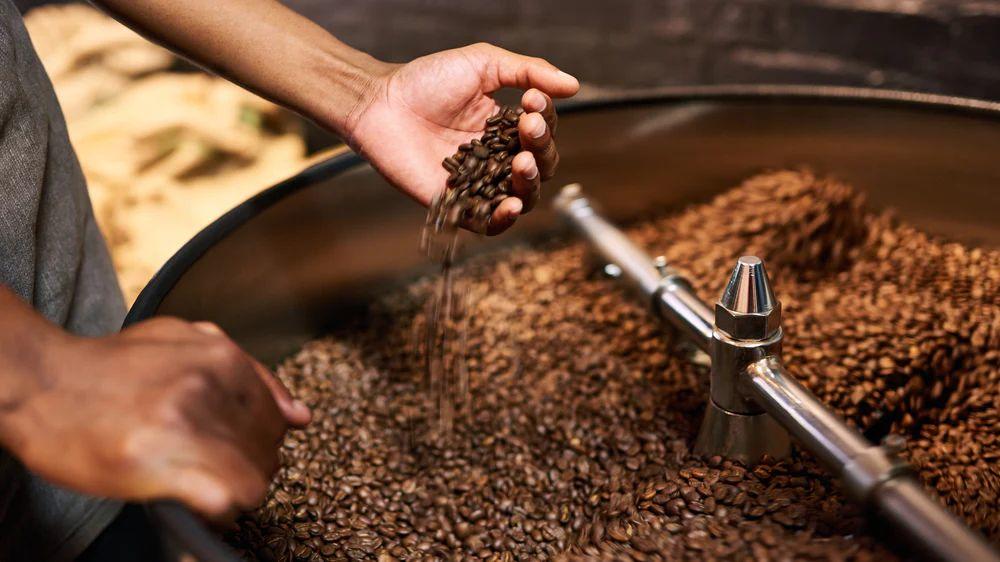
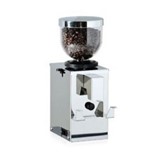
-160x160-state_article-rel-cat.png)
